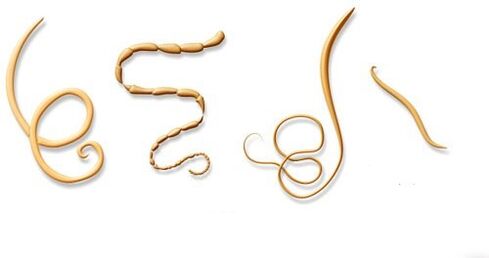Parasites are the simplest organisms that live on humans. For nutrition, they use cells, vitamins, substances, tissues - everything that benefits our health.
In addition, parasites are known to poison the body by releasing harmful substances. Let's consider in more detail the symptoms of the presence of parasites in the human body, their habitat, how to get rid of them and preventive measures against their appearance.
Damage from parasites in the body
First of all, the organs' ability to work is disturbed, ie inflammation occurs, which destroys the tissue. Often these alien creatures produce toxins which over time contribute to the poisoning of the entire organism.

The microorganisms living in the intestine feed on nutrients that get into the stomach together with food. As a result, the first symptom of the presence of a parasite in the body appears: a person has a slowdown in growth, as well as a violation of mental and physical development.
Parasites can live for years, and eggs with larvae are very resistant to the surrounding microflora.For example, in the digestive system, for their own defense, they release substances that inactivate enzymes that process food during metabolism.
The digestion processes are then interrupted. Therefore, sometimes the symptoms of the presence of parasites in the human body often resemble gastrointestinal diseases.
Common parasites
The most common human parasites are:
- Lice- the bite of these arthropods first irritates the skin and then turns into eczema or purulent lesions;
- pinworms- small round worms with a white tint that cause a disease such as enterobiasis;
- Roundwormsare parasitic worms whose vital activity takes place in the intestinal tract. The length of the male sexually mature individual reaches 24 cm, the female up to 40 cm;
- Whipworm- ranks 3rd in terms of the frequency of the disease. Infection with this parasite causes a disease - trichocephalosis. The female of this parasite is large and reaches 5. 5 cm, the male is slightly smaller - from 4 to 5 cm;
- Giardia- live in two formations: vegetative and spore forms. In the first case, their vital activity takes place in the upper part of the small intestine, in the second - in the large intestine;
- cat accident- affects the liver and provokes the appearance of opisthorchiasis;
- Trichinae- round worms. Cause helminth invasion;
- toxocara- similar to the roundworm, only the diameter of the larva is 0. 02 mm;
- Intestinal acne- a filamentous parasite up to 2 mm long;
- nekator- The larvae of the toothworm invade the body through the pores of the legs while walking barefoot. Your path begins with the right atrium and ends with the pulmonary artery. They break the walls of the capillaries and get into the alveoli and from there through the airways into the pharynx.

Paths of infection
You can be infected in a number of ways. Each of them is linked to the development cycle of a particular parasite. However, there are three main sources of infection in medicine:
- Through food and water.However, contamination often occurs due to improper storage and preparation. But sometimes there is an initial infection, that is, when a product infected with parasites has undergone poor heat treatment;
- Through the contact household method.In this case, the infection is transmitted from another person or another pet.
- Through blood-sucking insects.This path is also known as transmission.
- By communicating with petswho walk on the street.

There are larvae that are able to invade the human body independently. A symptom of the presence of a parasite of this form is dermatobiasis disease. In this case, the larva gets on the skin, gnaws on it itself and ends up in the host's body.
Signs of the presence of parasites
We recommend considering 10 main functions:
- constipation.Blockage of the organs of the digestive system can occur as the size of the worms interferes with the normal course of peristalsis or secretion. An abundance of them closes the ducts (bile and intestines) and makes it difficult to pass stool.
- diarrhea.There are parasitic living organisms that produce hormone-like substances that cause watery stools.
- Bloat, gasis another factor in the presence of worms. If you do not pay attention to periodic flatulence, then the symptom of the presence of parasites in the human body appears with varying intensity and for several months, and sometimes years.
- irritable bowel syndrome.Parasites can not only irritate, but also cause inflammation. This leads to a decrease in the rate of assimilation of substances.
- Pain in muscle tissue and joints.In order to find the most comfortable environment, some microorganisms move around the body. More often, they choose muscles or synovial fluid. Hence, a person suffers from pain and often attributes the symptom to the effects of arthritis. The symptom is also believed to be the result of an injury to muscle tissue worms.
- allergy.Toxins often increase the dose of eosinophil production. It is this substance that inflames tissues and causes allergies.
- skin problems.Often times, worms cause rashes, eczema and urticaria. Their presence also leads to skin ulcers, dermatitis, swelling and papillomas. When the gastrointestinal tract is infected, the face becomes covered with early wrinkles, baldness appears, cracks are visible on the heels, and the nails become brittle.
- anemia.As mentioned earlier, parasites suck up all nutrients and a large amount of them cause blood loss. As a result, the body lacks iron.
- Overweight.The symptom is associated with the defeat of the body by tapeworms. It means one thing: a protective reaction of the human body due to poisoning with products that contribute to the vital activity of parasites.
- nervousness.Toxins produced by microorganisms irritate the central nervous system. As a result, a person develops depression, an increase in anxiety, and nervousness.


watch out! Diarrhea and constipation are not only the consequences of malnutrition, but also the first symptoms of the presence of parasites in the human body.
Identification based on appearance
Depending on the location of their vital activity, parasites are divided into two types:
- Endoparasites(worms, lamblia, echinococcus, etc. ) - those who live inside;
- Ectoparasites,live outside (lice, fleas, bed bugs).
Ectoparasite infestation can easily be identified by its appearance. A rash appears on the body, which is accompanied by itching, redness and burning sensation. Often small wounds (penetration points) remain at the site of his bite.

The determination of the endoparasite infestation is more difficult because they live in the body. These parasites have learned to adapt to their host's body during evolution. Studies have shown that it sometimes takes months or even decades from the time of infection to the onset of primary symptoms.
How to diagnose a disease
An invasion can be diagnosed by the following symptoms:
- pale skin;
- gastrointestinal problems;
- lesion of the upper layer of the dermis;
- cosmetic problems;
- weight jumps;
- occurrence of chronic fatigue syndrome;
- regular headaches;
- teeth grind in sleep;
- swelling of the limbs;
- pain in joints and muscles;
- disorder of the central nervous system;
- Itching in the perineum and anus.
Is treatment always necessary?
When infected, the human body weakens, becomes allergic and is poisoned by toxins. Of course, the rapid development of these symptoms is not observed, but the lack of treatment often causes serious health problems.
Medicines from the pharmacy
The most effective drugs include the following drugs:
- for ascariasis: piperazine adipate and pyrantel;
- for enterobiasis: mebendazole;
- of paragonimiasis, schistosomiasis, opisthorchiasis,
- for Echinococcus: mebendazole;
- from beef tapeworm: praziquantel.
Popular folk remedies
In addition to garlic and white pumpkin seeds as the three most useful products against parasite infestation, nature has created three plants that can cleanse the human body when the first symptoms of parasite infestation appear: cloves, walnuts and wormwood.
Cleansing the body of enterobionts with walnuts.Pour 0. 5 liters of vodka into the green crust of 15 walnuts and place in a dark place for a month. Take within 5 days of dissolving a drop of the tincture in 0. 1 liter of water. After that, increase the dosage to 2 -2. 5 tsp. and take it 2 times a day for a whole year.

Cleansing with the medicinal herb wormwood.Grind dried plant seeds. Reception should start with a pinch. By the 15th day of admission, the dosage should reach 1. 5 hours. After that, take 0. 5 tsp per day. Use the same dosage only once a week.
Cleans the body with clove seeds.Grind the seeds to a powdery state. You need to start with 1. 5 tsp, gradually reducing the dosage to one spoon. The entry course is 10 days.
Infection prevention
As soon as the parasite enters our body, it passes through three environments:
- Alkaline (oral cavity);
- Sour (stomach);
- Alkaline (bile).
If everything is fine with every barrier, don't be afraid of a single parasite. Even if it is already present in the body, it is excreted naturally. However, if at least one barrier is breached, it means a breach of the entire system.
First of all, in order to prevent infection, it is necessary to regularly observe the hygiene of hands and the entire body, clean up the oral cavity: cure sick teeth, bleeding gums, stomatitis and get rid of unpleasant odor.

Second, you should establish a drinking regimeand follow a proper diet.
Third, eliminate the stagnation of the bile.
And of course you shouldn't forget the general hygiene rules to prevent parasitic diseases.








































